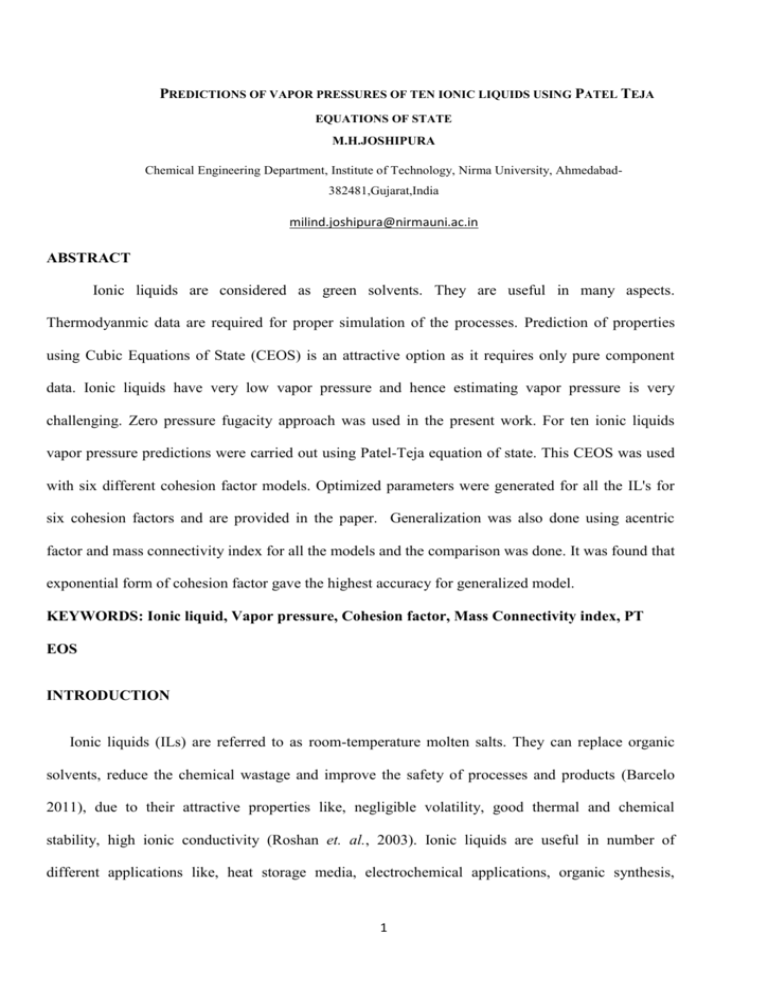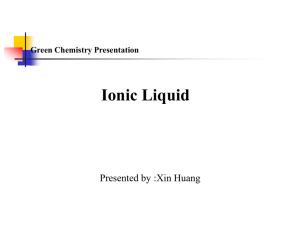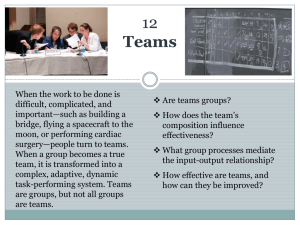temperature peng
advertisement

PREDICTIONS OF VAPOR PRESSURES OF TEN IONIC LIQUIDS USING PATEL TEJA
EQUATIONS OF STATE
M.H.JOSHIPURA
Chemical Engineering Department, Institute of Technology, Nirma University, Ahmedabad382481,Gujarat,India
milind.joshipura@nirmauni.ac.in
ABSTRACT
Ionic liquids are considered as green solvents. They are useful in many aspects.
Thermodyanmic data are required for proper simulation of the processes. Prediction of properties
using Cubic Equations of State (CEOS) is an attractive option as it requires only pure component
data. Ionic liquids have very low vapor pressure and hence estimating vapor pressure is very
challenging. Zero pressure fugacity approach was used in the present work. For ten ionic liquids
vapor pressure predictions were carried out using Patel-Teja equation of state. This CEOS was used
with six different cohesion factor models. Optimized parameters were generated for all the IL's for
six cohesion factors and are provided in the paper. Generalization was also done using acentric
factor and mass connectivity index for all the models and the comparison was done. It was found that
exponential form of cohesion factor gave the highest accuracy for generalized model.
KEYWORDS: Ionic liquid, Vapor pressure, Cohesion factor, Mass Connectivity index, PT
EOS
INTRODUCTION
Ionic liquids (ILs) are referred to as room-temperature molten salts. They can replace organic
solvents, reduce the chemical wastage and improve the safety of processes and products (Barcelo
2011), due to their attractive properties like, negligible volatility, good thermal and chemical
stability, high ionic conductivity (Roshan et. al., 2003). Ionic liquids are useful in number of
different applications like, heat storage media, electrochemical applications, organic synthesis,
1
absorption of gases, reaction solvents and many others. Vapor pressure is important for many
reasons; some of them are listed below (Rebleo et. al., 2005),
Important in several applications of ionic liquids like Potential solvents,
For understanding of phase transition
For the development of models for other thermodynamic properties
Experimental vapor pressure data for ionic liquids are very less. Thus, the development of
models for correlating and predicting the vapor pressure of ionic liquids has been slow. Recently
Valderrama et.al, 2012 proposed an analytical expression for vapor pressure prediction of ionic
liquids based on PR (Peng and Robnison, 1976) equation of state using low pressure fugacity. In
present study same concept is used for prediction of vapor pressure using Patel Teja (PT) (Patel and
Teja, 1982) Equations of state. Six cohesion factors available in the literature were compared for
prediction of vapour pressure using PT EOS.
DATABASE & MODELLING
Experimental vapor pressure data for ten (10) ionic liquids belonging to two different
families were considered for the study. The details are given in Table 1. Temperature, pressure and
experimental vapor pressure data ranges are shown in Table 2. Critical properties for all the ILs were
calculated by the model proposed by Valderrama et. al., 2008.
Table 1 Details of vapor pressure data used
Sr.No
Ionic liquid
family
No. of ionic
liquids
Data points
Reference
1
[NTf2]
9
128
7
2
[dca]
1
5
8
Table 2 Range of temperature, and experimental vapor pressure
Parameter
Minimum
2
Maximum
Temperature (K)
445.30
538.2
Pressure (bar)
0.69×10-7
9.27×10-5
Vapour pressure prediction using CEOS requires a proper cohesion factor expression. In
present study six cohesion functions were studied. The model equations of all the cohesion factors
are presented in Table 3. Vapor pressure data were fitted to obtain the values of compound specific
parameters for all cohesion functions. For the purpose of optimizing parameters of cohesion
functions ten ionic liquids, 9 from [NTf2] and 1 from [dca] family were used. An algorithm for
optimizing cohesion factor parameter(s) using low pressure fugacity approach is shown in Fig. 1.
Optimized parameters for the six cohesion factors are listed in Table 4. These parameters were
generalized using acentric factor and mass connectivity index. Generalization of single parameter
models and SV model were done by minimizing the sum of the square of the difference of optimized
parameters and calculated parameters. For Hyene-2 and GL model perturbation approach suggested
by Figueria et. al. 2007 was adopted. Generalized expressions are given in Table 5 for all the models.
For Hyene-2 and GL models one needs to solve the two expressions to get the values of m and n
parameters.
RESULTS AND DISCUSSIONS
In present study vapor pressures were estimated and compared in terms of %AAD using low
pressure fugacity approach. %AAD is defined follows,
Psat Exp
%AAD = (100 ∗ Abs (P sat Cal − Psat
Exp
))/𝑁
(1)
The %AAD values for optimized and generalised parameters are listed in Table 6. SV model
was found to be better compared to all.
Table 3 Six Cohesion Functions used in the present study
3
Cohesion function
Model equation
Reference
2
T
α(T) = [1 + m (1 − √ )]
Tc
Soave
10
T
}]
Tc
T n
α(T) = exp [m2 {1 − ( ) }]
Tc
α(T) = exp [m1 {1 −
Joshipura
Heyen-2
11
4
SV
α(T) = {1 + [m + n(1 + √Tr )(0.7 − Tr )(1 − √Tr )]}
GL
α(T) = 1 + m(Tr − 1) + n(√Tr − 1)
1
α(T) =
1 + m(Tr 2/3 − 1)
Polishuk
2
12
12
13
Table 4 Optimized Parameters for six cohesion factors
Optimized cohesion parameters for PT EOS
Cohesion function
Sr.No
Ionic liquid
abbreviation
Soave
m
Joshipura
Heyen-2
m
n
m
SV
m
GL
n
m
Polishuk
n
m
1
[C2C1im][NtF2]
1.3902
1.3798
1.0238
1.8913
1.9194
-1.0041
-3.0943
1.4502
0.7488
2
[C3C1im][NtF2]
1.3390
1.3375
1.0153
1.7565
1.7835
-0.8563
-2.6835
0.9652
0.7344
3
[C4C1im][NtF2]
1.3053
1.3104
1.0551
1.5277
1.6459
-0.6483
-1.4805
-0.8865
0.7257
4
[C5C1im][NtF2]
1.2652
1.2775
1.1677
1.1741
1.4440
-0.3397
-0.0541
-3.0660
0.7136
5
[C6C1im][NtF2]
1.2277
1.2468
1.1975
1.0730
1.3518
-0.2335
0.3040
-3.5360
0.7022
6
[C7C1im][NtF2]
1.2015
1.2250
1.2405
0.9787
1.2109
-0.0178
1.3589
-5.1538
0.6938
7
[C8C1im][NtF2]
1.1843
1.2105
1.2457
0.9521
1.2032
-0.0355
1.2340
-4.9030
0.6882
8
[C10C1im][NtF2]
1.1597
1.1910
1.5723
0.6493
1.0117
0.2728
2.6245
-7.0578
0.6803
9
[C12C1im][NtF2]
1.0845
1.1276
1.5197
0.6279
0.9092
0.3160
2.9254
-7.3108
0.6553
10
[bmim][dca]
1.5101
1.4675
2.6688
0.4499
1.2215
0.6791
6.6173
-14.8085
0.7928
However, all the models fitted the data with less than 5% AAD. For generalized
models however, single parameter models were better. Joshipura et. al., 2010 was showing
the least deviation.
4
Table 5 Generalized cohesion factors expressions
Cohesion
function
Soave
Correlation based on low pressure fugacity for PT EOS
Joshipura
m = 0.0556λ2 − 0.4871λ + 0.1203ω + 2.1749
Heyen-2
1 + 𝑚𝑛 = 0.4235𝜆2 − 2.6734𝜆 − 2.001𝜔 + 7.3275
𝑚𝑛(𝑛 − (1 + 𝑚𝑛)) = −0.1239𝜆2 + 1.1693𝜆 − 0.2155𝜔 − 3.8984
SV
𝑚 = 0.3338𝜆2 − 2.1892𝜆 − 1.8460𝜔 + 5.6364
𝑛 = −0.6892𝜆2 + 4.0103𝜆 + 3.7304𝜔 − 7.4507
1 − 𝑚 𝑛⁄2 = 0.4942𝜆2 − 3.1057𝜆 − 3.4818𝜔 + 8.7115
𝑛⁄ = 0.0210𝜆2 − 0.2449𝜆 − 6.5158𝜔 + 2.2388
4
m = 0.0160λ2 − 0.1598λ − 0.0146ω + 1.0410
GL
Polishuk
m = 0.639λ2 − 0.5781λ − 0.0854ω + 0.4160
Table 6 %AAD for Generalized and optimized cohesion factors
Sr.No.
Cohesion function
%AAD(Global)
Generalized cohesion
Optimized
parameters
cohesion factors
1
Soave
11.0755
4.1784
2
Joshipura
10.7851
3.8767
3
Heyen-2
12.3596
0.9592
4
SV
21.6180
0.7538
5
GL
25.8195
0.7804
6
Polyshuk
11.1882
4.4805
CONCLUSIONS
Low pressure fugacity approach was applied to predict the vapor pressures of ten ionic
liquids. Effect of cohesion factor was observed during the study. It was found that most of the
mathematical form of cohesion factor works well for compound specific models but the exponential
form (Joshipura et. al., 2010) and two parameter polynomial12 works better for generalized ones.
However, Joshipura et. al., 2010 type functions can be considered as superior as the model uses only
5
single adjustable parameters. This will be useful when predicting properties of the mixtures. It was
also observed that PR EOS is predicting vapor pressure accurately compared to PT EOS. The study
was limited to vapor pressure and that too for a limited number of compounds. The future work will
concentrate on predicting other properties using various cohesion factor models and comparing them.
1. Nomenclature
P
Pressure
T
Temperature
EOS
Equation of state
PR
Peng-Robinson
PT
Patel-Teja
Greek symbols
ω
acentric factor
ϕv
vapour phase fugacity coefficient
ϕL
liquid phase fugacity coefficient
fv
vapour phase fugacity
fL
liquid phase fugacity
Subscripts
r
Reduced
sat
Saturated
c
Critical
6
2. References
[1] Barcelo, P, (2011),Thermodynamics of room temperature ionic liquid., PhD Thesis, University
of Aberdeen.
[2] Roshan, N. and Ghader, S.,(2003), Developing models for correlating ionic liquids density:
Part 1 – Density at 0.1 MPa. Fluid Phase Equilibria, 331, 33-47.
[3] Rebelo, P.N., Canongia, J.N., Esperanc, J.M., and Filipe E.,(2005).
On the Critical
Temperature, Normal Boiling Point, and Vapor Pressure of Ionic Liquids. Journal. Phys.
Chem. B 109, 6040-6043.
[4] Valderramaa, J.O., and Luis A. F.,(2012), An analytical expression for the vapor pressure of
ionic liquids based on an equation of state. Fluid Phase Equilibria , 317, 77-83.
[5] Peng, D.Y. and Robinson, D.B.,(1976), A New Two Constant Equation of State. Ind. Eng.
Chem. Fundam., 15, 59-64.
[6] Patel, N. C., and Teja, A. S., (1982). A new cubic Equation of State for fluids and fluid
mixtures. Chem. Eng. Sci, 37 No. 3, , 463-473.
[7] Vladimir, N., Emel, Y., Sergey, P., and Andreas, H.,(2007), The Gaseous Enthalpy of
Formation of the Ionic Liquid 1-Butyl-3-methlylimidazolium Dicyanamide from Combustion
Calorimetry, Vapour pressure Measurements, and Ab Intio Calculations. J. Am. Chem. Soc.
129, 3930-3937.
[8] IUPAC Ionic Liquids Database (IL Thermo),
http://ilthermo.boulder.nist.gov/ILThermo/mainmenu.uix, July 2011.
[9] Valderrama, J.O., Wilson, W., and Juan, A.(2008) Critical Properties, Normal Boiling
Temperature, and Acentric Factor of Another 200 Ionic Liquids. Ind. Eng. Chem. Res 47,
1318-1330.
7
[10] Soave , G., (1972) Equilibrium constants from a modified Redlich-Kwong equation of state.
Chem. Eng. Sci. 27, 1197-1203.
[11] Joshipura, M. H., Dabke, S.P., and Subrahmanyam, N., (2010) Development of Compound
Specific Cohesion Function Relationship for SRK Equation of State. Indian Chemical
Engineer, 52:2, 116-127.
[12] Freddy, L. Figueria, L. L., and Claudio, O., (2007) Generalized Parameters of the StryjekVera and Gibbons-Laughton cohension functions for use with cubic EOS of the van der waals
type. Fluid Phase Equilibria, 259, 105-115.
[13] Polishuk, I., (2009) ,Generalized Cubic Equation of State Adjusted to the Virial Coefficients
of Real Gases and its Prediction of Auxiliary Thermodynamic Properties Ind. Eng. Chem.
Res. 48, 10708-10717..
8







